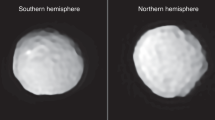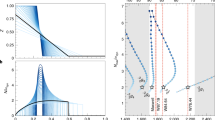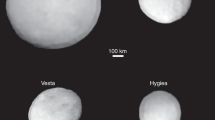Abstract
BEFORE the arrival of the Galileo spacecraft in the jovian system, there was little information on the interior structure of Jupiter's largest moon, Ganymede. Its mean density (1,940 kg m−3), determined by the Pioneer and Voyager spacecraft1–3, implies a composition that is roughly 60% rock and 40% ice, which could be uniformly mixed or differentiated into a rocky core and icy mantle4. Here we report measurements by the Galileo spacecraft of Ganymede's overall density and the spherical harmonics, J2 and C22, of its gravitational field. These data show clearly that Ganymede has differentiated into a core and mantle. Combined with the recent discovery of an intrinsic magnetic field5,6, our gravity results suggest that Ganymede has a metallic core of radius 400–1,300 km surrounded by a silicate mantle, which is in turn enclosed by an ice shell ∼800 km thick. Depending on whether the core is pure iron or an alloy of iron and iron sulphide, it could account for as little as 1.4% or as much as one-third of the total mass. If the ice were stripped away, Ganymede could look much like Io7 in terms of its size and internal mass distribution.
This is a preview of subscription content, access via your institution
Access options
Subscribe to this journal
Receive 51 print issues and online access
$199.00 per year
only $3.90 per issue
Buy this article
- Purchase on Springer Link
- Instant access to full article PDF
Prices may be subject to local taxes which are calculated during checkout
Similar content being viewed by others
References
Null, G. W., Anderson, J. D. & Wong, S. K. Science 12, 476–477 (1975).
Null, G. W. Astron. J. 81, 1153–1161 (1976).
Campbell, J. K. & Synnott, S. P. Astron. J. 90, 364–372 (1985).
Schubert, G., Spohn, T. & Reynolds, R. T. in Satellites (eds Burns, J. A. & Matthews, M. S.) 629–688 (Univ. Arizona Press, Tucson, 1986).
Kivelson, M. G. et al. Nature 384, 537–541 (1996).
Gurnett, D. A., Kurth, W. S., Roux, A., Bolton, S. J. & Kennel, C. F. Nature 384, 535–537 (1996).
Anderson, J. D., Sjogren, W. L. & Schubert, G. Science 272, 709–712 (1996).
Moyer, T. D. Tech. Rep. No. RT32-1527 (Jet Propulsion Lab., Pasadena, 1971).
Anderson, J. D., in Experimental Gravitation (ed. Bertotti, B.) 163–1299 (Academic, New York, 1974).
Tapley, B. D. in Recent Advances in Dynamical Astronomy (eds Taply, B. D. & Szebehely, V.) 396–425 (Reidel, Dordrecht, 1973).
Kaula, W. M. Theory of Satellite Geodesy (Blaisdell, Waltham, MA, 1966).
Cohen, E. R. & Taylor, B. N. Phys. Today 49, BG9–BG13 (1996).
Davies, M. E. et al. Celest. Mech. Dyn. Astron. 53, 377–397 (1992).
Woo, R. & Armstrong, J. W. J. Geophys. Res. 84, 7288–7296 (1979).
Kaula, W. M. An Introduction to Planetary Physics: The Terrestrial Planets (Wiley, New York, 1968).
Hubbard, W. B. & Anderson, J. D. Icarus 33, 336–341 (1978).
Dermott, S. F. Icarus 37, 310–321 (1979).
Zharkov, V. N., Leontjev, V. V. & Kozenko, A. V. Icarus 61, 92–100 (1985).
Schubert, G., Limonadi, D., Anderson, J. D., Campbell, J. K. & Giampieri, G. Icarus 111, 433–440 (1994).
Jeffreys, H. The Earth (Cambridge Univ. Press, 1962).
Schubert, G., Zhang, K., Kivelson, M. G. & Anderson, J. D. Nature 384, 544–545 (1996).
Malhotra, R. Icarus 94, 399–412 (1991).
Segatz, M., Spohn, T., Ross, M. N. & Schubert, G. Icarus 75, 187–206 (1988).
Peale, S. J., Cassen, P. & Reynolds, R. T. Science 203, 892–894 (1979).
Author information
Authors and Affiliations
Rights and permissions
About this article
Cite this article
Anderson, J., Lau, E., Sjogren, W. et al. Gravitational constraints on the internal structure of Ganymede. Nature 384, 541–543 (1996). https://doi.org/10.1038/384541a0
Received:
Accepted:
Issue Date:
DOI: https://doi.org/10.1038/384541a0
This article is cited by
-
Interiors of Earth-Like Planets and Satellites of the Solar System
Surveys in Geophysics (2022)
-
Estimation of the Ephemerides and Gravity Fields of the Galilean Moons Through Orbit Determination of the JUICE Mission
Aerotecnica Missili & Spazio (2021)
-
Ice-Ocean Exchange Processes in the Jovian and Saturnian Satellites
Space Science Reviews (2020)
-
Relict Ocean Worlds: Ceres
Space Science Reviews (2020)
-
Large Ocean Worlds with High-Pressure Ices
Space Science Reviews (2020)
Comments
By submitting a comment you agree to abide by our Terms and Community Guidelines. If you find something abusive or that does not comply with our terms or guidelines please flag it as inappropriate.



